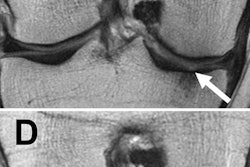
The price of an outpatient noncontrast MRI scan of the knee can vary across the U.S. by almost eightfold, according to a new study in the May issue of the Journal of the American College of Radiology. The finding sheds light on an increasingly consumer-driven healthcare environment, researchers from the Mayo Clinic in Rochester, MN, wrote.
As legislators look for ways to curb healthcare spending, they've championed price transparency as a means of giving patients more control. But this tool can be limited because the pricing and reporting of healthcare services varies widely, according to corresponding author Dr. David Kallmes and colleagues.
These limitations can be especially detrimental to the uninsured and those with high-deductible health plans.
"The motivation for this project was to help characterize the local and regional charges for a routine outpatient imaging procedure, as this information is often difficult to obtain, owing to lack of uniform transparency rules, variable reporting, and changes in payment rates," Kallmes and colleagues wrote.
Location, location, location
Using 2010 U.S. Census data, the group identified what it called "localities" -- that is, population clusters such as towns and cities -- with the highest populations for each state. The researchers analyzed the data they collected by locality and by U.S. region.
Kallmes and colleagues randomly chose nonhospital outpatient MRI centers in each state's highest-population area, based on data from the American College of Radiology's (ACR) MRI accreditation program database; each area had to have at least two and a maximum of three centers to be included in the study. The researchers further parsed data into three population brackets: 50,000 to 500,000, 500,000 to 1 million, and more than 1 million. The study included a total of 122 outpatient centers from 43 localities (JACR, May 2015, Vol. 12:5, pp. 444-452).
 Dr. David Kallmes from the Mayo Clinic.
Dr. David Kallmes from the Mayo Clinic.Between March and April 2013, the researchers contacted these centers by phone to determine the lowest out-of-pocket cost for a knee MR scan (both technical and professional fee) -- posing as a 21-year-old male college student who had injured his knee playing football. Kallmes and colleagues wrote and used a standardized script for these calls, with the essential question being: "What is the best price for a noncontrast knee MRI with all discounts included if I am uninsured and paying completely out of pocket?"
They found that prices for the exam ranged from $259 to $2,042 across all centers included in the study. Median cost differences between localities ranged from a high of $1,488 at a locality in the West to a low of $325 at a locality in the Midwest. And even within some localities prices varied among imaging centers by up to about $1,500.
The researchers did not find statistically significant cost differences among regions, however: The median cost for a knee MRI exam in the West, Northeast, Midwest, and South was $690, $500, $550, and $550, respectively (p = 0.849).
Kallmes' group found an inverse relationship between population density and cost, with less populated areas having higher costs than more densely populated ones. For example, the locality in the West with the highest median scan price was in the bracket with the lowest population, while the locality in the Midwest with the lowest median scan price was in the highest population bracket.
This suggests that competition for patients in highly populated areas influences scan prices, and the higher volume of procedures makes lower costs feasible.
"If you're in a busy city, there's going to be a lot of competition -- which will drive prices down," Kallmes told AuntMinnie.com.
It pays to shop around, the group concluded: In most areas, patients can save $200 or more if they compare prices.
"In the new high-deductible environment, patients will be paying for these high-cost diagnostic imaging procedures, and they're going to be sensitive to cost," Kallmes said. "That's going to drive their healthcare decisions."
Is there more than price?
But patients may not realize that price isn't the only way to determine the value of a service, the researchers wrote. Other quality measures should be considered as well.
"Particularly important are quality measures which include reading errors, complications from interventional procedures, and volume of services performed," they wrote. "Unfortunately, quality assessments are not as frequently reported as pricing, thereby preventing patients from making the most informed decision for care that holds the greatest value."
Further research in the vein of this study could combine pricing and quality data, Kallmes and colleagues suggested. And asking imaging centers more pointed questions could help, too.
"Consideration should be given to challenging centers with the prices of local competitors, to evaluate their response and reasoning for the difference in cost," they concluded.



.fFmgij6Hin.png?auto=compress%2Cformat&fit=crop&h=100&q=70&w=100)





.fFmgij6Hin.png?auto=compress%2Cformat&fit=crop&h=167&q=70&w=250)











